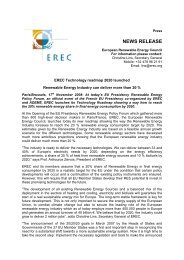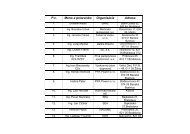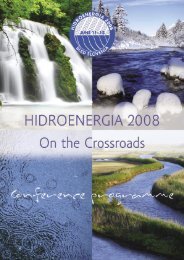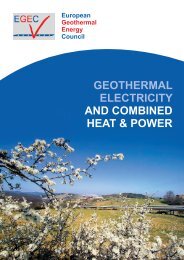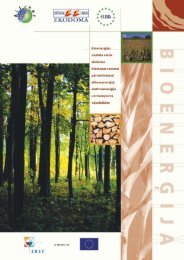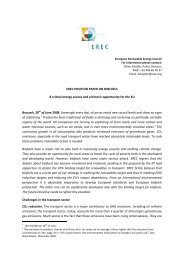CTO Assessment - European Commission
CTO Assessment - European Commission
CTO Assessment - European Commission
You also want an ePaper? Increase the reach of your titles
YUMPU automatically turns print PDFs into web optimized ePapers that Google loves.
WARMIA & MAZURY<br />
Biomass utilisation<br />
for energy purposes<br />
EC BALTIC RENEWABLE ENERGY CENTRE • RECEPOL • Centre of Excellence<br />
ul. Reduta Zbik 5 • 80 - 761 Gdansk • Poland<br />
Tel./Fax.: +48 58 301 57 88 • E-Mail: gdansk@ecbrec.pl • Website:www.ecbrec.pl<br />
The Region of Warmia and Mazury is located<br />
in North East Poland and has a<br />
structure of fuel consumption for heat production<br />
that is dominated by coal. Other<br />
major fuels include light oil and in larger<br />
towns also natural gas is used. District<br />
heating is common even in rural areas of<br />
this region which is among the least industrialised<br />
of Poland, and where there is high<br />
unemployment especially in rural areas.<br />
This project describes how biomass district<br />
heating plants (DHP) have been developed<br />
in the region to replace traditional<br />
fuels with a more environmental source of<br />
energy, at a time where refurbishment, or<br />
even replacement, of the old coal district<br />
heating systems is needed anyway for a<br />
significant amount of them.<br />
Main motivations<br />
The region is characterised by availability<br />
of wood fuels derived from forestry and<br />
local wood industry and a significant surplus<br />
of straw existing in the agricultural<br />
sector (forestation in 2001 was 30%),<br />
there was the opportunity to put an end to<br />
the heavy reliance on local fossil fuels.<br />
The typical owners of local district heating<br />
systems are local authorities, which in that<br />
region seem to be often poorer than in other<br />
regions of the country. As such, local investors<br />
have to search for external funding,<br />
which since the end of 90’s is hardly<br />
available for fossil fuels while it can be<br />
accessed for RES projects. Typically this<br />
difficult situation led to biomass replacing<br />
the old heating systems, while at the same<br />
time creating new jobs.<br />
The Project<br />
Having gained inspiration and knowledge<br />
of modern applications of biomass technologies<br />
already implemented especially in<br />
the EU, the regional authorities of Warmia<br />
& Mazury recognised the opportunities for<br />
the wider deployment of renewable energy<br />
in the region. The political will to stimulate<br />
wider deployment of biomass technologies<br />
was then translated into allocation of a<br />
high priority by the Regional authorities<br />
set in the list of priority investment to be<br />
co-funded by the Regional Fund for Environmental<br />
Protection. At the end of 90-<br />
ties some pilot investment projects were<br />
developed, that later became a basis for<br />
spreading out good practices and further<br />
replication in other communes of Warmia<br />
& Mazury.<br />
Innovative aspects<br />
The first projects have been to a certain<br />
extent the direct replications of technological<br />
solutions from the EU. However, growing<br />
interest in the utilisation of biomass<br />
for heat production in the region led to<br />
using some local engineering and manufacturing<br />
capacities and using some locally<br />
invented technological improvements helping<br />
to decrease the cost of biomass application<br />
while improving their efficiency.<br />
Challenges<br />
A major barrier faced especially in the<br />
initial period of the development of biomass<br />
DHP in the region was a mental<br />
barrier among the local decision–makers.<br />
Typical prejudices about biomass<br />
resulted from the lack of knowledge and<br />
a strong perception of coal or gas/oil as<br />
the only modern and secure options for<br />
local energy production. Especially the<br />
utilisation of straw faced a strong distrust<br />
as it was believed to have too low<br />
calorific value and also perhaps considered<br />
as going back to “ stone age technology”.<br />
Financing tools to support biomass<br />
projects on the regional level were provided<br />
by the Regional Environmental<br />
Protection Fund. At the end of the 90’s<br />
they started to provide soft loans and<br />
subsidies with a high priority given to<br />
biomass projects. At an early stage, special<br />
conditions were created for local<br />
authorities, allowing to write off up to<br />
50% of debt provided that these funds<br />
are then used for further environmental<br />
investments. First investments were<br />
characterised by high costs typical to applications<br />
of new technologies and the<br />
lack of experience in this field. However,<br />
with a growing number of biomass investments,<br />
investment costs of further<br />
replication projects decreased (e.g. by<br />
30 % in case of some straw-fired installations).<br />
Replication Potential<br />
Warmia & Mazury Region can be used as<br />
good example for the other regions of Poland<br />
and other countries of CEECs. It seems<br />
that regional authorities may indeed play<br />
an important role in the deployment of RES<br />
technologies at a local level especially if<br />
they can access some regional financing<br />
schemes such as environmental funds.<br />
Boosting Regional Bioenergy Utilization<br />
(1999 – 2003)<br />
The efforts of Warmia and Mazury regional<br />
authorities have been well in line<br />
with the Polish National RES Strategy<br />
endorsed by the Council of Ministers in<br />
2000 and approved by the Polish Parliament<br />
in August 2001 that set a target to<br />
increase the share of RES in the primary<br />
energy balance of Poland from 2.5% in<br />
1999 to 7.5% in 2010. In 1999-2003 in<br />
the Region of Warmia and Mazury over<br />
30 local biomass DHP were installed with<br />
the total capacity of 90 MW.<br />
80 <strong>CTO</strong> - Showcase




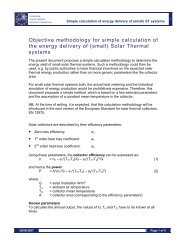
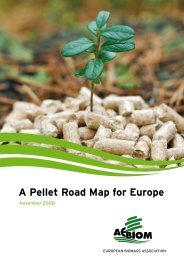
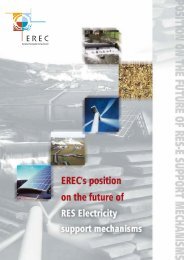

![Energy [R]evolution - Greenpeace](https://img.yumpu.com/47174859/1/184x260/energy-revolution-greenpeace.jpg?quality=85)
